- Improving lives since 2002
- Fast, Friendly Service
- Free Nutritional Counseling
The key to health is eliminating toxicities and deficiencies! - Dr. William R. Kellas
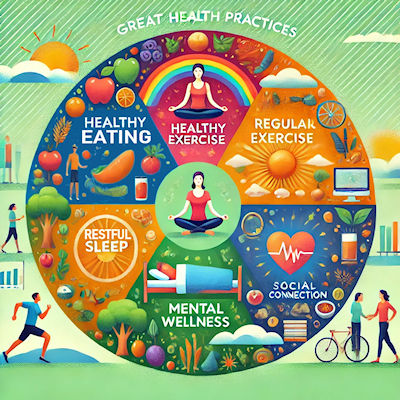
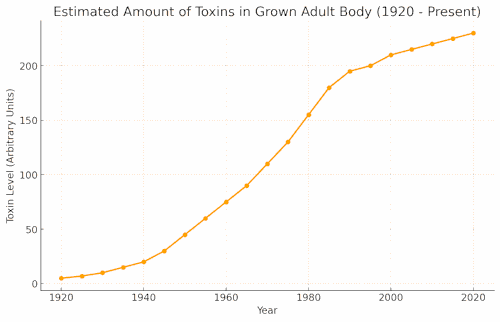

Because of the competitive and interfering interactions of toxins, it’s crucial to minimize exposure to heavy metal and other toxins and support the body’s ability to detoxify.

Anyone who has ever had fish knows that if you don't regularly clean the fish bowl it becomes filthy and the fish die. So, if you want dead fish, just don't clean the fish bowl.
Likewise, your cells cannot thrive if the fluids of your body are filled with toxins and just like fish will die way too soon.
The constant degradation of cellular health from toxic damage removes decades of lifespan and healthspan potential.
So, both for fish bowls or human bodies, we need to keep the internal environment clean. Trying to be healthy while living in internal toxicity doesn't work. Below are the some of the best practices for getting those toxins out of you. You should be doing as many as you can.
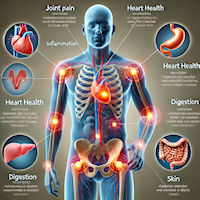
Toxins damage cells and tissues resulting in chronic inflammation.
Chronic inflammation gives rise to pain, joint stiffness, damaged skin, and diseases such as heart disease, diabetes, kidney disease, liver disease, and autoimmune disorders. The accumulation of inflammatory damage ultimately kills us regardless how nutritious is our food or what other good health practices we have.
Direct DNA Damage: Toxins like heavy metals (e.g., mercury, lead) and chemical carcinogens (e.g., benzene, formaldehyde) can directly damage DNA by breaking strands or causing chemical modifications, leading to mutations that disrupt cell function and increase disease risk.
Oxidative Stress: Toxins such as air pollutants and chemicals in processed foods produce reactive oxygen species (ROS), which cause oxidative stress and DNA damage, resulting in mutations and potential health issues.
DNA Methylation: Exposure to toxins like tobacco smoke, pesticides, and heavy metals can alter DNA methylation patterns, affecting gene expression. DNA methylation can silence important genes that prevent uncontrolled cell growth or repair DNA, potentially leading to cancer and other health conditions.
Histone Modifications: Toxins such as BPA and phthalates can impact histone proteins, altering gene activation patterns and potentially causing developmental or metabolic issues.
Impact on Cellular Aging: Toxins like air pollution and smoking accelerate telomere shortening, leading to premature aging and higher susceptibility to age-related diseases. Shortened telomeres are associated with cellular deterioration.
Inhibition of DNA Repair Proteins: Some toxins, including certain plastics and pesticides, interfere with DNA repair enzymes, reducing the body’s ability to fix DNA damage. This leads to the accumulation of genetic errors over time.
Interference with Cell Cycle Control: Toxins disrupt cell cycle checkpoints, increasing the likelihood of replication errors and propagation of mutations.
Oncogene Activation: Exposure to toxins such as tobacco smoke or asbestos can activate oncogenes, leading to uncontrolled cell division and potential tumor formation.
Tumor Suppressor Silencing: Toxins may silence tumor suppressor genes through epigenetic changes, allowing cells to evade natural growth control mechanisms, which can lead to unchecked cell growth.
Toxins from processed foods, alcohol, and pollutants can damage the intestinal lining, impairing nutrient absorption. Heavy metals like lead and mercury can make the gut “leaky,” reducing its ability to absorb nutrients effectively.
Enzymes are necessary to break down food for nutrient absorption. Toxins, such as pesticides and industrial chemicals, inhibit enzyme activity, which reduces nutrient availability, especially for proteins and complex carbohydrates.
Toxins from antibiotics, alcohol, and artificial additives disrupt gut bacteria balance. This imbalance affects nutrient synthesis, especially for vitamins like B and K, and impairs nutrient absorption, leading to deficiencies.
Some toxins, such as heavy metals like cadmium, lead, and mercury, compete with essential minerals like zinc, calcium, and iron for absorption sites, limiting access to these necessary nutrients.
Fat-soluble toxins, like dioxins and PCBs, can bind to fat molecules, disrupting the absorption of essential fat-soluble vitamins (A, D, E, and K) and affecting various bodily functions.
Many toxins trigger inflammation in the gut, which can impair nutrient absorption. Increased immune cell activity in the gut due to inflammation can alter gut permeability and inhibit nutrient uptake.
The detoxification process itself uses up nutrients, particularly B vitamins, antioxidants, and amino acids. Constant toxin exposure diverts these nutrients away from essential bodily functions, effectively reducing their availability.
Protecting yourself from modern toxins involves a multi-layered approach, as they can be present in air, food, water, personal care products, and household items. Here are effective steps to reduce your exposure to toxins and thus protect your health:
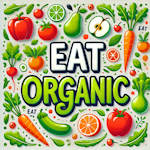
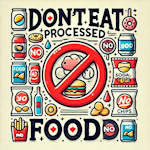


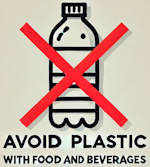
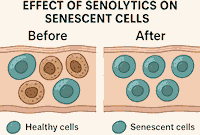
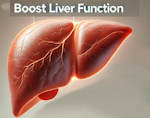
 Glutathione levels decrease in human beings from age 23 until death by nearly 2 percent a year (see graph).
Glutathione levels decrease in human beings from age 23 until death by nearly 2 percent a year (see graph).
So, supplementing with Glutathione boosters is a key practice for staying healthy. Glutathione is a Phase II detoxifier. It binds with toxins and take them out of the body via the urine. It binds with other antioxidants. Studies have found that centenarians — people who live to be 100 or older have much higher levels of glutathione than their peers.
We particularly recommend these Vitamin C products:
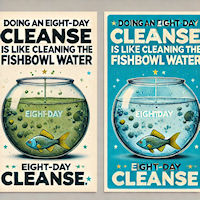 Doing an Eight Day Cleanse two to four times per year is a great way to detoxify the body. The Eight Day Cleanse utilizes numerous synergistic products to help clear the body of many types of toxins, parasites, and pathogens while removing mucoidal plaque from intestinal linings. This Cleanse was designed by Dr. William R. Kellas for his patients at the Center for Advanced Medicine in Encinitas California. It was fine-tuned with tens of thousands of patient results.
Doing an Eight Day Cleanse two to four times per year is a great way to detoxify the body. The Eight Day Cleanse utilizes numerous synergistic products to help clear the body of many types of toxins, parasites, and pathogens while removing mucoidal plaque from intestinal linings. This Cleanse was designed by Dr. William R. Kellas for his patients at the Center for Advanced Medicine in Encinitas California. It was fine-tuned with tens of thousands of patient results.
Doing an Eight Day Cleanse is like changing dirty water for clean water in your fishbowl (speaking of your body as the fishbowl). The Cleanse is one of the best ways to quickly dissolve mucoidal plaque from the gastrointestinal system. Clean bowels are super beneficial to long term health. If the bowels aren't clean the bloodstream is constantly toxified. The Eight Day Cleanse utilizes Paragon and Silver Biotics to destroy parasites and pathogens and E7 to quench free radicals. In just eight days a person goes from filthy to much cleaner internally.

Another top recommendation for getting toxins out of the body is sweating (via sauna or exercise). Sweating is a safe way for most people to detoxify and be cleaner internally. Sweating causes toxins to leave cells and go out of the body via the sweat glands. That means that those toxins don't have to go through the liver and kidneys to get out of the body, thus avoiding exit damage to the kidneys and liver.
A Finish study showed that people who sweat profusely three to five times a week outlive those who don't (2,000 person study). And they have less incidence of disease. Check out our Relax Far Infrared Sauna information. The benefits of sweating are too good to ignore.
We recommend purchasing a Relax Fir Sauna and doing three 40 minute saunas per week.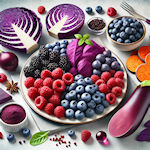
At a recent Anti-Aging exposition, those who were taking PXP Royale were among those who had no free radical damage (very rare).

Eating Iodine rich foods such as seaweed or oysters (shown to the right), or supplementing with Oyster Max or with Magnascent Iodine is important to staying detoxified and healthy. 96% of Americans are deficient in Iodine. Iodine is important for detoxification, primarily through its critical role in supporting thyroid function to increase mitochondrial energy output. It takes energy to detoxify. Without enough iodine, therefore, your body will function like someone who is too tired to clean up the house after a long day's work.
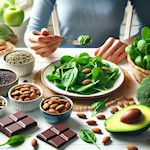
Eating Magnesium rich foods such as pumpkin seeds, chard, spinach, dark chocolate, kale, almonds, avocado, tofu, quinoa, flaxseed, salmon, etc. (shown to the right), or supplementing with ACE Ormus is important to staying detoxified and healthy. 75% of Americans are deficient in Magnesium. Like Iodine, Magnesium is important for detoxification, primarily through its role in increasing mitochondrial energy output. It takes energy to detoxify. Without enough magnesium, therefore, the cells don't have extra energy to devote to detoxification.
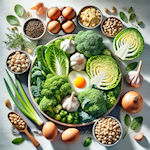


Eat all of your daily allotment of food during a 5 to 11 hour window each day and do not eat any closer than three hours to bed time. This enables the body to do better housekeeping and removal of toxins.
The reason is that limiting the time when the gastrointestinal tract has to be working frees up considerable amounts of energy that is otherwise using in metabolizing food. This energy can be diverted to detoxify and repair the cells of the body.
Interestingly, limiting the time for eating is the only absolutely sure-fire method that will always (in every case) increase lifespan of test animals by nearly double.
So, choose a period of time in which you will eat, such as from 6 AM to Noon or 1PM to 7PM each day. There is nothing special when this window of time is. The eating window could be longer such as eating from 5 AM to 12 Noon or 6 am to 4pm. The maximum window should be 11 hours and the minimum window should be at least five hours. Eating should not occur closer than three hours to bedtime. You can drink water and non-calorie containing such as tea during the time of day when you aren't eating.

Multi-day water fasting (up to 50 days) is one of the quickest ways to detoxify the body. Note that quickest isn't always the best.
The reason that water fasting works so well to detoxify the body is that the body totally freaks out (in a good way) about the loss of incoming calories and searches the body for any calorie sources that can be burned to make energy. In this scavenging for calories process the body will choose to dismantle fat storage first (where many toxins are stored) so that the fatty acids can be burned for energy. The stored toxins are released during this process and can be excreted from the body. If one fasts long enough, stored toxins will be thoroughly cleansed from the body.
Warning: Fasting can be very difficult. We recommend warming up to a long term fast (40 days or more) by starting with a 24 hour fast. Later on, one can do a 72 hour fast. We then recommend a 10-day fast, then a 20-day fast, and finally a 40 or 50 day fast. Be sure to have a physical exam, inform your medical professional of your intention. Join, a Facebook group devoted to fasting, and go into this with your eyes-wide open.
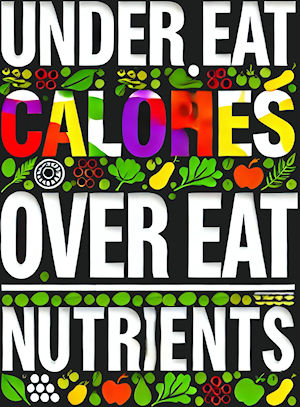
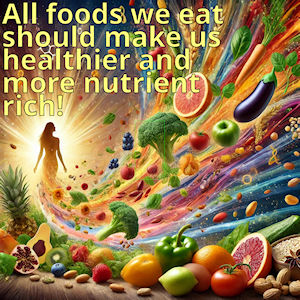
Unless one is so physically active that all incoming calories are burned up in physical exertions, then excess calories will eventually be stored as fat.
The accumulation of fat, plus stress, plus lack of sleep turns one's metabolism toward the sugar burning mode. Being a sugar burner is extremely unhealthy, leading to chronic health challenges and early death.
If that's not bad enough, by itself, which it is, calorie-rich foods have another bad characteristic, namely, they eliminate nutrients already in the body, lowering one's nutrient reserves.
This is the discipline of those who choose to be wise about health. If the food doesn't contribute to my life, I won't eat it.

We are all looking for a dessert that is awesome, and that provides more nutrients than calories. We suggest preparing a dessert with monk fruit instead of sugar. Also, we suggest adding Berry Extreme to most any dessert. Berry Extreme has so many nutrients and few calories, helping to fix the nutrient deficiency. For instance, add it to a custard or to ice cream, giving a wonderful berry flavor addition.
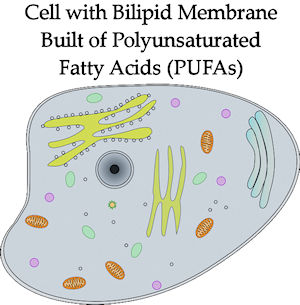
The reason they can be the best or the worst is that Parent Omega Oils (alpha linolenic acid and linoleic acid) incorporate into cell membranes. Once in the membranes those fatty acids either help pull oxygen into the cell or resist its movement into the cell. And, that makes a huge difference to health.
Parent Omega Oils are highly reactive fatty acids. They are essential to life, which is why we also call them Parent Essential Oils.
In this regard of pulling oxygen into cells, Parent Omega Oils function far differently than saturated fatty acids or mono-unsaturated fatty acids which are primarily sources of energy. They do not integrate into cell membranes.
Because Parent Omega Oils can be become adulterated care must be taken to ensure only perfect Parent Omega Oils are consumed. Adulterated Parent Omega Oils will damage health because when they incorporate into cell membranes they resist oxygen from going into the cell interior (the opposite of what is wanted).
Interestingly, all modern vegetable oils today are adulterated. They are adulterated on purpose to prevent them from attracting oxygen into themselves and going rancid. By adulterating the oils before bottling, they are less likely to go rancid, and will smell better longer. Unwittingly, however, the consumer buys oils that undermine their cellular oxygenation and health.
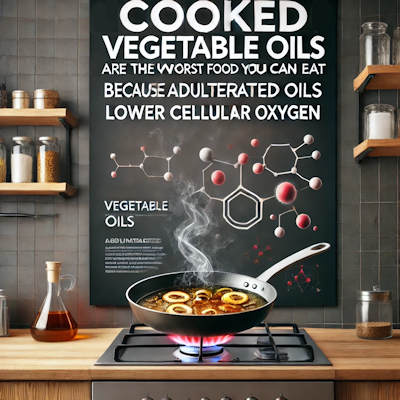
With the above understandings, one will avoid adulterated Parent Omega Oils and consume non-adulterated Parent Omega Oils. The only issue is finding non-adulterated Parent Omega Oils. We do offer these oils on our web site. Learn more at https://healthy-living.org/peos.
<< Pop Up 1 - Enter Your Content Here >>
<< Pop Up 2 - Enter Your Content Here >>
Copyright 2002 - 2024. All rights reserved.
These statements have not been evaluated by the Food and Drug Administration. No product mentioned herein is intended to diagnose, treat, cure or prevent any disease. If you are pregnant, nursing, taking medication, or have a medical condition, consult your physician before making any lifestyle change, including trying a new product or food.
The information on this website is intended as a sharing of knowledge and information from the research and experience of the Healthy-Living.Org staff and contributors. It is not intended to replace a one-on-one relationship with a qualified health care professional and it is not intended as medical advice. You should not use the information on this site for diagnosis or treatment of any health problem or for modification of any medication regimen. You should consult with a healthcare professional before starting any diet, exercise or supplementation program, before starting or discontinuing any medication, or if you suspect you have a health problem. You should keep in mind that cited references to ongoing nutritional scientific study are most likely not accepted by the FDA as conclusive. These references and mentions of benefits experienced by others are disavowed as product claims and are only included for educational value and as starting points for your own research. No food or supplement can be considered safe for all individuals. What may benefit 999,999 of a million people may harm you. Therefore, no one can take responsibility for your health except you in concert with your trusted health professional.